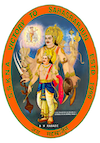For generations Somavaunshiya Sahasrarjun Kshatriaya (SSK) genealogy is historically maintained by the Bhats. They visit the SSK family homes at convenient intervals. They identify each family with their gotras, relate them to their ancestral royal heritage and read the family history from their written books called Potis. They update the current birth and death records of every family they visit. To entertain, educate and instill pride in SSK heritage they also quote many folklores written in their Potis. They also evoke pouranic episodes related to Sahasrarjun. Many of ancestral and mythological past folkores come from word of mouth and Puranas. It is interesting to note Bhats are the main source of any written past.It is every SSKian pride and heritage to know their past ancestral roots and pass on to their children. This type of ancestral information will bond the community living apart. For the benefit of the foreign born SSK children, I have briefly presented here with the simple illustrations these folklores. These stories are directly related to Sahasrarjun our Patriarch, and Hinglajimata our Kuldevata. More stories will be illuminated as they are available.
Bhats claim they have maintained SSK family records since the birth of our patriarch Rajrajeshwar Kartiviryarjun. The earlier records kept by Bhats were written on dried leaves, on wooden boards, or on clothes etc. These old improperly kept records were approximated. Many times no proper dates or family birth or deaths were recorded. Displaced from Mandavagad later generations of Bhats with divided geographic responsibly were either did not know how to maintain such a high volume of old Potis or they had economic reasons. Even I have heard another rumor from leading community leaders that the safely stored in wooden containers of old Potis were burnt to ashes during hindu muslim rivalry encouraged by invading Moghal conquerors. The current Bhat claim that remaining ones are too fragile to carry around. They have lost moisture, and have become deteriorated and brittle. To open these records they have to sprinkle them with water to soften. Presently these are bundled and stacked on the shelves at the homes of Bhats in Rajasthan. Bhats protect the privacy of these records. They say the records were in Modi (Nagarik lipi) script, which has a tendency to change with time. They have been kept under strict privacy, they claim their livelihood depends on them. The present Bhats carry around an updated and properly documented version of thousand year of SSK history record books (potis).
Bhats reason that a thousand years ago Kshatriya community basically dissolved at Mandwagad, where our ancestors had ruled for generations. Our community lacked unity and had developed antagonisms with powerful Brahmin community. Added to this were Muslim invasions caused terror they had never seen. The breaking points came when Muslim conquerors chased after our SSK beautiful women. Not accepting this type of behavior SSK families in a mass migration moved out of Mandawagad( Maheshwar in MP) initially settled in south and elsewhere. In search of a secure life and looking for new business opportunities many have wandered and migrated to various locations ever since. These families left Mandawagad moved first to Gujarath. Many divided families ventured in to new territories. They proceeded to Maharashtra and further down south to Karnatak. From Bijapur, they branched out. Within the families, few went to Bhagyanagar (Hyderabad), other regions of Karnatak and southern Maharashtra. Some proceeded to northern regions of India such as Bihar up to Nepal. Bhats say our Kshatriya community elsewhere is addressed as Rajputs, Khatries, Khats. Major SSK settlements are in the regions Karnak, Hyderabad (Andra Pradesh), Maharashtra, Tamil Nadu and Gujarath regions.
Bhat families, among themselves, have allotted various geographic regions. Their tour lasts 2-3 months. This cycle repeats to other regions. On completion of their tour they return to Rajasthan and rest. They seem to take a big break after they complete all the tours, each planned tour is limited by how many heavy records they can carry, the geographic area they cover and our population density in the chosen region. The family histories are all hand written and are kept in bound books (Poti). The heavily used or damaged pages are copied and then duplicated in loosely bound packages. On arrival to the chosen geographic region, they contact the local leaders ( Samaj panchas) of SSK communities, who make their boarding arrangements at their Samaj Temples or Dharmashala rooms. They send the community messenger to announce the local families of their arrival. Bhats request the SSK families to invite them on voluntary basis to their homes. At the SSK homes, family members gather around to attend the ceremonial puja of their records (pothis). Bhats then identify the families with their gotras, relate them to their ancestral royal heritage. They update the family birth and death records regularly. Then they chant the family history.The information for this article was collected from our Bhat Maluji and his son Mohan Chavan of Dadota, District Nayor, Rajasthan, India, at their North Karnatak camp on February 2007. Formerly this family covered Gujarath region. Their late uncle Indrajitasa Chavan of Lahogava, Parabhani( Maharashtra) covered southern states such as Karnatak and Maharashsta.


























